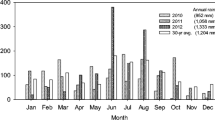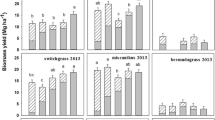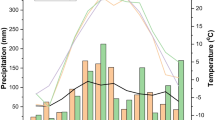Abstract
Although perennial grasses are being evaluated as a renewable source of biomass for energy production in many countries, no information exits regarding the use of these grasses in Uruguay. In 2008, an 8-year field study was implemented in western Uruguay to determine harvest frequencies for optimal biomass yield and nutrient removal for selected grass species. Elephantgrass (Pennisetum purpureum Schum.), giant reed (Arundo donax L.), and switchgrass (Panicum virgatum L.) were compared using two harvest frequencies: a single harvest after freeze (August) or two harvests (January and August) per year. We evaluated biomass yield, moisture content, nutrient concentration, and nutrient removal of these grasses. This study demonstrated the ability of these grasses to produce high biomass yields. Across years, the double harvest system significantly reduced cumulative biomass yield (~15%) compared to the single harvest of elephantgrass and giant reed; however, switchgrass had 18% more biomass yield (12.70 Mg ha−1 year−1) than the other grasses at the summer harvest but no cumulative difference was detected. The single winter harvest of elephantgrass had the highest cumulative biomass yield (140.8 Mg ha−1) and total nutrient removal (563 k N ha−1, 199 kg P ha−1, 2704 kg K ha−1) across a 6-year period among the grasses. Switchgrass may be the grass best suited for dual use systems under Uruguayan conditions because a farmer may utilize initial growth as forage while biomass regrowth is a good direct combustion o biofuel feedstock due to lower moisture content and nutrient removal compared to the other species evaluated.



Similar content being viewed by others
References
Naik SN, Goud VV, Rout PK, Dalai AK (2010) Production of first and second generation biofuels: a comprehensive review. Renew Sust Energ rev 14:578–597
McLaughlin SB, Kszos LA (2005) Development of switchgrass (Panicum virgatum) as a bioenergy feedstock in the United States. Biomass Bioenergy 28:515–535
Roth AM, Sample DW, Ribic CA, Paine L, Understander DJ, Bartelt GA (2005) Grassland bird response to harvesting switchgrass as a biomass energy crop. Biomass Bioenergy 28:490–498
Angelini GL, Ceccarini L, Bonari E (2005) Biomass yield and energy balance of giant reed (Arundo donax L.) cropped in central Italy as related to different management practices. Eur J Agron 22:375–389
Lewandowski I, Scurlock JMO, Lindvall E, Christou M (2003) The development and current status of perennial rhizomatous grasses as energy crops in the US and Europe. Biomass Bioenergy 25:335–361
Mariani C, Cabrini R, Danin A, Piffanelli P, Fricano A, Gomarasca S (2010) Origin, diffusion and reproduction of the giant reed (Arundo donax L.): a promising weedy energy crop. Ann Appl Biol 157(2):191–202
Knoll JE, Anderson WF, Strickland TC, Hubbard RK, Malik R (2012) Low-input production of biomass from perennial grasses in the coastal plain of Georgia, USA. Bioenergy res 5(1):206–214
Mohammed YA, Chen C, Lee D (2014) Harvest time and nitrogen fertilization to improve bioenergy feedstock yield and quality. Agron J 106(1):57–65
Sanderson MA, Read JC, Reed RL (1999) Harvest management of switchgrass for biomass feedstock and forage production. Agron J 91:5–10
Guretzky JA, Biermacher JT, Cook BJ, Kering MK, Mosali J (2011) Switchgrass for forage and bioenergy: harvest and nitrogen rate effects on biomass yields and nutrient composition. Plant Soil 339:69–81
Shastri YN, Hansen AC, Rodríguez LF, Ting KC (2012) Switchgrass practical issues in developing a fuel crop. CAB Reviews 7:1–14
Balasko JA, Burner DM, Thayne WV (1984) Yield and quality of switchgrass grown without soil amendments. Agron J 76:204–208
Calhoun DS, Prine GM (1985) Response of elephantgrass to harvest interval and method of fertilization in the colder subtropics. Soil Crop Sci Soc Fla Proc 44:111–115
Dragoni F, Ragaglini G, Nassi o Di Nasso N, Tozzini C, Bonari E (2015) Aboveground yield and biomass quality of giant reed (Arundo donax L.) as affected by harvest time and frequency. Bioenergy res 8(3):1321–1331
Sanderson MA, Wolf DD (1995) Switchgrass biomass composition during morphological development in diverse environments. Crop Sci 35:1432–1438
Balan V, Kumar S, Bals B, Chundawat S, Jin M, Dale B (2012) Biochemical and thermochemical conversion of switchgrass to biofuels. Switchgrass. In: Monti A (ed) A valuable biomass crop for energy. Springer-Verlag, London, pp 153–185
Madakadze IC, Coulman BE, McElroy AR, Stewart KA, Smith DL (1998) Evaluation of selected warm-season grasses for biomass production in areas with a short growing season. Bioresour Technol 65:1–12
Waramit N, Moore KJ, Heggenstaller AH (2011) Composition of native warm-season grasses for bioenergy production in response to nitrogen fertilization rate and harvest date. Agron J 103:655–662
Yang J, Worley E, Wang M, Lahner B, Salt DE, Saha M, Udvardi M (2009) Natural variation for nutrient use and remobilization efficiencies in switchgrass. Bioenergy Research 2:257–266
Mitchell R, Vogel KP, Sarath G (2008) Managing and enhancing switchgrass as a bioenergy feedstock. Biofuels, Bioproducts and Biorefining-Biofpr 2:530–539
Dragoni F, Nassi o Di Nasso N, Tozzini C, Bonari E, Ragaglini G (2016) Nutrient concentrations and uptakes in giant reed (Arundo donax L.) as affected by harvest time and frequency. Bioenerg res 9:671–681
Littel RC, Milliden GA, Stroup WW, Wolfinger RD (1996) SAS system for mixed models. SAS Inst Cary, Cary
Angelini LG, Ceccarini L, Nassi o Di Nasso N, Bonari E (2009) Comparison of Arundo donax L. and Miscanthus × giganteus in a long-term field experiment in Central Italy: analysis of productive characteristics and energy balance. Biomass Bioenergy 33:635–643
Woodard KR, Prine GM (1991) Forage yield and nutritive value of elephantgrass as affected by harvest frequency and genotype. Agron J 83:541–546
Monti A, Di Virgilio N, Venturi G (2008) Mineral composition and ash content of six major energy crops. Biomass Bioenergy 32:216–223
Nassi O Di Nasso N, Angelini LG, Bonari E (2010) Influence of fertilisation and harvest time on fuel quality of giant reed (Arundo donax L.) in central Italy. Eur J Agron 32:219–227
Na C, Sollenberger LE, Erickson JE, Woodard KR, Vendramini JMB, Silveira ML (2015) Management of perennial warm-season bioenergy grasses. I. Biomass harvested, nutrient removal, and persistence responses of elephantgrass and energycane to harvest frequency and timing. Bioenerg Res 8:581–589
Smith R, Slater FM (2011) Mobilization of minerals and moisture loss during senescence of the energy crops miscanthus giganteus, Arundo donax and Phalaris arundinacea in Wales, UK. Glob Chang Biol Bioenergy 3:148–157
Adler PR, Sanderson MA, Boateng AA, Weimer PJ, Jung HG (2006) Biomass yield and biofuel quality of switchgrass harvested in fall or spring. Agron J 98:1518–1525
Knoll JE, Johnson JM, Huang P, Dewey R, William L, Anderson F (2015) Effects of delayed winter harvest on biomass yield and quality of napiergrass and energycane. Biomass Bioenergy 80:330–337
Heaton EA, Dohleman FG, Long SP (2009) Seasonal nitrogen dynamics of Miscanthus × giganteus and Panicum virgatum. GCB Bioenergy 1:297–307
Acknowledgments
The authors would like to thank Julio Mosqueira, Juan Mosqueira, Reinaldo Quintana, and Edith Elliot (Agronomy Faculty, UDELAR) for assistance in planting, maintaining, and harvesting field plots and for technical assistance in the laboratory. This research was funded by PDT 79.1-MEC, CSIC-UDELAR, and the Agronomy Faculty.
Author information
Authors and Affiliations
Corresponding author
Rights and permissions
About this article
Cite this article
Siri Prieto, G., Ernst, O. & Bustamante, M. Impact of Harvest Frequency on Biomass Yield and Nutrient Removal of Elephantgrass, Giant Reed, and Switchgrass. Bioenerg. Res. 10, 853–863 (2017). https://doi.org/10.1007/s12155-017-9847-2
Published:
Issue Date:
DOI: https://doi.org/10.1007/s12155-017-9847-2




